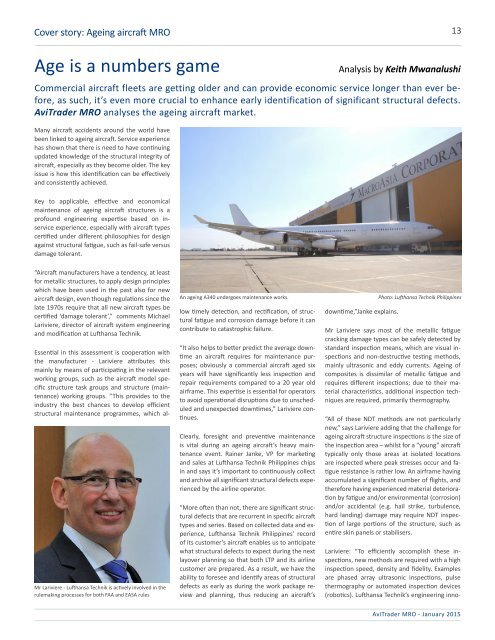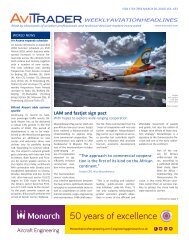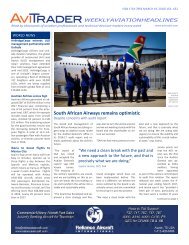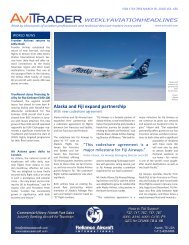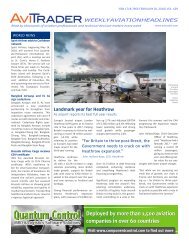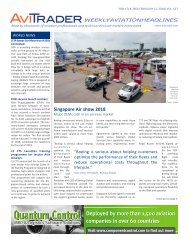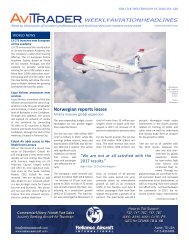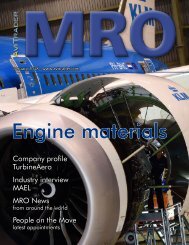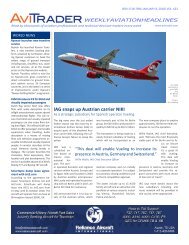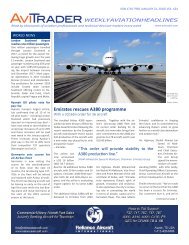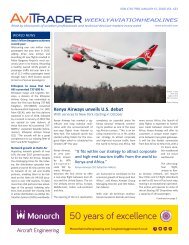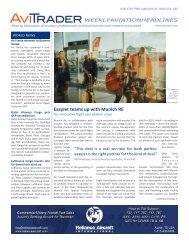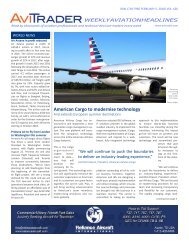AviTrader_Monthly_MRO_e-Magazine_2015-01
AviTrader_Monthly_MRO_e-Magazine_2015-01
AviTrader_Monthly_MRO_e-Magazine_2015-01
You also want an ePaper? Increase the reach of your titles
YUMPU automatically turns print PDFs into web optimized ePapers that Google loves.
Cover story: Ageing aircraft <strong>MRO</strong><br />
13<br />
Age is a numbers game<br />
Commercial aircraft fleets are getting older and can provide economic service longer than ever before,<br />
as such, it’s even more crucial to enhance early identification of significant structural defects.<br />
<strong>AviTrader</strong> <strong>MRO</strong> analyses the ageing aircraft market.<br />
Many aircraft accidents around the world have<br />
been linked to ageing aircraft. Service experience<br />
has shown that there is need to have continuing<br />
updated knowledge of the structural integrity of<br />
aircraft, especially as they become older. The key<br />
issue is how this identification can be effectively<br />
and consistently achieved.<br />
Analysis by Keith Mwanalushi<br />
Key to applicable, effective and economical<br />
maintenance of ageing aircraft structures is a<br />
profound engineering expertise based on inservice<br />
experience, especially with aircraft types<br />
certified under different philosophies for design<br />
against structural fatigue, such as fail-safe versus<br />
damage tolerant.<br />
“Aircraft manufacturers have a tendency, at least<br />
for metallic structures, to apply design principles<br />
which have been used in the past also for new<br />
aircraft design, even though regulations since the<br />
late 1970s require that all new aircraft types be<br />
certified ‘damage tolerant’,” comments Michael<br />
Lariviere, director of aircraft system engineering<br />
and modification at Lufthansa Technik.<br />
Mr Lariviere - Lufthansa Technik is actively involved in the<br />
rulemaking processes for both FAA and EASA rules<br />
An ageing A340 undergoes maintenance works.<br />
Essential in this assessment is cooperation with<br />
the manufacturer - Lariviere attributes this<br />
mainly by means of participating in the relevant<br />
working groups, such as the aircraft model specific<br />
structure task groups and structure (maintenance)<br />
working groups. “This provides to the<br />
industry the best chances to develop efficient<br />
structural maintenance programmes, which allow<br />
timely detection, and rectification, of structural<br />
fatigue and corrosion damage before it can<br />
contribute to catastrophic failure.<br />
“It also helps to better predict the average downtime<br />
an aircraft requires for maintenance purposes;<br />
obviously a commercial aircraft aged six<br />
years will have significantly less inspection and<br />
repair requirements compared to a 20 year old<br />
airframe. This expertise is essential for operators<br />
to avoid operational disruptions due to unscheduled<br />
and unexpected downtimes,” Lariviere continues.<br />
Clearly, foresight and preventive maintenance<br />
is vital during an ageing aircraft’s heavy maintenance<br />
event. Rainer Janke, VP for marketing<br />
and sales at Lufthansa Technik Philippines chips<br />
in and says it’s important to continuously collect<br />
and archive all significant structural defects experienced<br />
by the airline operator.<br />
“More often than not, there are significant structural<br />
defects that are recurrent in specific aircraft<br />
types and series. Based on collected data and experience,<br />
Lufthansa Technik Philippines’ record<br />
of its customer’s aircraft enables us to anticipate<br />
what structural defects to expect during the next<br />
layover planning so that both LTP and its airline<br />
customer are prepared. As a result, we have the<br />
ability to foresee and identify areas of structural<br />
defects as early as during the work package review<br />
and planning, thus reducing an aircraft’s<br />
downtime,”Janke explains.<br />
Photo: Lufthansa Technik Philippines<br />
Mr Lariviere says most of the metallic fatigue<br />
cracking damage types can be safely detected by<br />
standard inspection means, which are visual inspections<br />
and non-destructive testing methods,<br />
mainly ultrasonic and eddy currents. Ageing of<br />
composites is dissimilar of metallic fatigue and<br />
requires different inspections; due to their material<br />
characteristics, additional inspection techniques<br />
are required, primarily thermography.<br />
“All of these NDT methods are not particularly<br />
new,” says Lariviere adding that the challenge for<br />
ageing aircraft structure inspections is the size of<br />
the inspection area – whilst for a “young” aircraft<br />
typically only those areas at isolated locations<br />
are inspected where peak stresses occur and fatigue<br />
resistance is rather low. An airframe having<br />
accumulated a significant number of flights, and<br />
therefore having experienced material deterioration<br />
by fatigue and/or environmental (corrosion)<br />
and/or accidental (e.g. hail strike, turbulence,<br />
hard landing) damage may require NDT inspection<br />
of large portions of the structure, such as<br />
entire skin panels or stabilisers.<br />
Lariviere: “To efficiently accomplish these inspections,<br />
new methods are required with a high<br />
inspection speed, density and fidelity. Examples<br />
are phased array ultrasonic inspections, pulse<br />
thermography or automated inspection devices<br />
(robotics). Lufthansa Technik’s engineering inno-<br />
<strong>AviTrader</strong> <strong>MRO</strong> - January <strong>2<strong>01</strong>5</strong>


